Understanding the Spontaneous Spreading of Stone Bunds in Ethiopia: Implications for Sustainable Land Management
Abstract
1. Introduction
2. Conceptual and Theoretical Frameworks
2.1. Conceptual Framework
2.2. Theoretical Framework
3. Research Methodology
3.1. Description of the Study Area
3.2. Sampling Techniques
3.3. Data Collection and Analysis
4. Results
4.1. Perceived Farmland Characteristics
4.2. Stone Bunds Characteristics
4.3. Perceived Effects of Stone Bunds
5. Discussion
6. Conclusions and Recommendation
Author contributions
Funding
Acknowledgments
Conflicts of Interest
References
- Central Statistical Agency (CSA). Key Findings of the 2014/2015 (2007 e.C.) Agricultural Sample Surveys; The Federal Democratic Republic of Ethiopia, Central Statistical Agency: Addis Ababa, Ethiopia, 2015; p. 16.
- Bekele, W.; Drake, L. Soil and water conservation decision behavior of subsistence farmers in the eastern highlands of Ethiopia: A case study of the hunde-lafto area. Ecol. Econ. 2003, 46, 437–451. [Google Scholar] [CrossRef]
- Asrat, P.; Belay, K.; Hamito, D. Determinants of farmers’ willingness to pay for soil conservation practices in the southeastern highlands of Ethiopia. Land Degrad. Dev. 2004, 15, 423–438. [Google Scholar] [CrossRef]
- Amsalu, A.; de Graaff, J. Determinants of adoption and continued use of stone terraces for soil and water conservation in an Ethiopian highland watershed. Ecol. Econ. 2007, 61, 294–302. [Google Scholar] [CrossRef]
- Meijer, S.S.; Catacutan, D.; Ajayi, O.C.; Sileshi, G.W.; Nieuwenhuis, M. The role of knowledge, attitudes and perceptions in the uptake of agricultural and agroforestry innovations among smallholder farmers in sub-saharan africa. Int. J. Agric. Sustain. 2015, 13, 40–54. [Google Scholar] [CrossRef]
- Tadesse, M.; Belay, K. Factors influencing adoption of soil conservation measures in southern Ethiopia: The case of Gununo area. J. Agric. Rural Dev. Trop. Subtrop. 2004, 105, 49–62. [Google Scholar]
- Gete, Z.; Menale, K.; Pender, J.; Mahmud, Y. Stakeholder Analysis for Sustainable Land Management (SLM) in Ethiopia: Assessment of Opportunities, Strategic Constraints, Information Needs, and Knowledge Gaps, 2nd ed.; Environmental Economics Policy Forum for Ethiopia (EEPFE); International Food Policy Research Institute: Addis Ababa, Ethiopia, 2006. [Google Scholar]
- Hurni, H. Land degradation, famine, and land resource scenarios in Ethiopia. In World Soil Erosion and Conservation; Pimentel, D., Ed.; Cambridge University Press: New York, NY, USA, 1993; pp. 27–61. [Google Scholar]
- Shiferaw, B.; Holden, S. Soil erosion and smallholders’ conservation decisions in the highlands of Ethiopia. World Dev. 1999, 27, 739–752. [Google Scholar] [CrossRef]
- Snyder, K.A.; Ludi, E.; Cullen, B.; Tucker, J.; Zeleke, A.B.; Duncan, A. Participation and performance: Decentralised planning and implementation in Ethiopia. Public Admin. Dev. 2014, 34, 83–95. [Google Scholar] [CrossRef]
- Teshome, A.; de Graaff, J.; Kassie, M. Household-level determinants of soil and water conservation adoption phases: Evidence from north-western Ethiopian highlands. Environ. Manag. 2016, 57, 620–636. [Google Scholar] [CrossRef] [PubMed]
- Federal Democratic Republic of Ethiopia (FDRE). Growth and Transformation Plan (2010/11–2014/15); Federal Democratic Republic of Ethiopia, Ministry of Finance and Economic Development: Addis Ababa, Ethiopia, 2010; Volume 1, p. 127.
- Federal Democratic Republic of Ethiopia (FDRE). Growth and Transformation Plan II (GTP II) (2015/16-2019/20); Federal Democratic Republic of Ethiopia, National Planning Commission: Addis Ababa, Ethiopia, 2016; Volume 1.
- Danano, D. Sustainable Land Management Technologies and Approaches in Ethiopia; Sustainable Land Management Project (SLMP); Natural Resources Management Sector, Ministry of Agriculture and Rural Development of the Federal Democratic Republic of Ethiopia: Addis Ababa, Ethiopia, 2010.
- Wolka, K. Effect of soil and water conservation measures and challenges for its adoption: Ethiopia in focus. J. Environ. Sci. Technol. 2014, 7, 185–199. [Google Scholar] [CrossRef]
- Abdela, A.; Derso, D. Analyzing factors affecting adoption of soil and water conservation practice in eastern Ethiopia. Afr. J. Agric. Sci. Technol. (AJAST) 2015, 3, 356–364. [Google Scholar]
- Adimassu, Z.; Langan, S.; Johnston, R. Understanding determinants of farmers’ investments in sustainable land management practices in Ethiopia: Review and synthesis. Environ. Dev. Sustain. 2016, 18, 1005–1023. [Google Scholar] [CrossRef]
- Beshah, T. Understanding Farmers: Explaining Soil and Water Conservation in Konso, Wolaita and Wello, Ethiopia. Ph.D. Thesis, Wageningen Universtiy, Wageningen, The Netherlands, 2003. [Google Scholar]
- Amsalu, A.; de Graaff, J. Farmers’ views of soil erosion problems and their conservation knowledge at beressa watershed, central highlands of Ethiopia. Agric. Hum. Valume 2006, 23, 99–108. [Google Scholar] [CrossRef]
- Teshome, A.; de Graaff, J.; Ritsema, C.; Kassie, M. Farmers’ perceptions about the influence of land quality, land fragmentation and tenure systems on sustainable land management in the north western Ethiopian highlands. Land Degrad. Dev. 2016, 27, 884–898. [Google Scholar] [CrossRef]
- German, L.; Mowo, J.; Kingamkono, M. A methodology for tracking the “fate” of technological interventions in agriculture. Agric. Hum. Valume 2006, 23, 353–369. [Google Scholar] [CrossRef]
- World Overview of Conservation Approaches and Technologies (WOCAT). Where the Land is Greener—Case Studies and Analysis of Soil and Water Conservation Initiatives Worldwide; Centre for Development and Environment (CDE): Bern, Switzerland, 2007. [Google Scholar]
- Liniger, H.P.; Gurtner, M.; Studer, R.M.; Hauert, C. Sustainable Land Management in Practice—Guidelines and Best Practices For Sub-Saharan Africa. Terrafrica, World Overview of Conservation Approaches and Technologies (WOCAT) and Food and Agriculture Organization of the United Nations (FAO); FAO: Rome, Italy, 2011; 243p. [Google Scholar]
- Hurni, H. Assessing sustainable land management (slm). Agric. Ecosyst. Environ. 2000, 81, 83–92. [Google Scholar] [CrossRef]
- Shiferaw, B.A.; Okello, J.; Reddy, R.V. Adoption and adaptation of natural resource management innovations in smallholder agriculture: Reflections on key lessons and best practices. Environ. Dev. Sustain. 2009, 11, 601–619. [Google Scholar] [CrossRef]
- Gebremichael, D.; Nyssen, J.; Poesen, J.; Deckers, J.; Haile, M.; Govers, G.; Moeyersons, J. Effectiveness of stone bunds in controlling soil erosion on cropland in the tigray highlands, northern Ethiopia. Soil Use Manag. 2005, 21, 287–297. [Google Scholar] [CrossRef]
- Vancampenhout, K.; Nyssen, J.; Gebremichael, D.; Deckers, J.; Poesen, J.; Haile, M.; Moeyersons, J. Stone bunds for soil conservation in the northern Ethiopian highlands: Impacts on soil fertility and crop yield. Soil Tillage Res. 2006, 90, 1–15. [Google Scholar] [CrossRef]
- Nedessa, B.; Yirga, A.; Seyoum, L.; Gebrehawariat, G. A Guideline on Documentation of Sustainable Land Management Best Practices in Ethiopia; Ministry of Agriculture, Natural Resource Sector: Addis Ababa, Ethiopia, 2015. [Google Scholar]
- Rogers, E.M. Diffusion of Innovations, 4th ed.; The Free Press: New York, NY, USA, 1995. [Google Scholar]
- Rogers, E.M. Diffusion of Innovations, 3rd ed.; The Free Press: New York, NY, USA, 1983. [Google Scholar]
- Straub, E.T. Understanding technology adoption: Theory and future directions for informal learning. Rev. Educ. Res. 2009, 79, 625–649. [Google Scholar] [CrossRef]
- Napier, T.L. Factors affecting acceptance and continued use of soil conservation practices in developing societies: A diffusion perspective. Agric. Ecosyst. Environ. 1991, 36, 127–140. [Google Scholar] [CrossRef]
- Carter, F.J., Jr.; Jambulingam, T.; Gupta, V.K.; Melone, N. Technological innovations: A framework for communicating diffusion effects. Inf. Manag. 2001, 38, 277–287. [Google Scholar] [CrossRef]
- Adesina, A.A.; Zinnah, M.M. Technology characteristics, farmers’ perceptions and adoption decisions: A tobit model application in Sierra Leone. Agric. Econ. 1993, 9, 297–311. [Google Scholar] [CrossRef]
- Owen, N.; Glanz, K.; Sallis, J.F.; Kelder, S.H. Evidence-based approaches to dissemination and diffusion of physical activity interventions. Am. J. Prev. Med. 2006, 31, 35–44. [Google Scholar] [CrossRef] [PubMed]
- Rogers, E.M. Diffusion of preventive innovations. Addict. Behav. 2002, 27, 989–993. [Google Scholar] [CrossRef]
- Reij, C.; Garrity, D. Scaling up farmer-managed natural regeneration in africa to restore degraded landscapes. Biotropica 2016, 48, 834–843. [Google Scholar] [CrossRef]
- Prager, K.; Posthumus, H. Socio-economic factors influencing farmers’ adoption of soil conservation practices in Europe. In Human Dimensions of Soil and Water Conservation; Napier, T.L., Ed.; Nova Science Publishers, Inc.: New York, NY, USA, 2010; pp. 203–223. [Google Scholar]
- Shiferaw, B.; Holden, S.T. Resource degradation and adoption of land conservation technologies in the Ethiopian highlands: A case study in Andit Tid, north Shewa. Agr. Econ. 1998, 18, 233–247. [Google Scholar] [CrossRef]
- Ntshangase, N.; Muroyiwa, B.; Sibanda, M. Farmers’ Perceptions and Factors Influencing the Adoption of No-Till Conservation Agriculture by Small-Scale Farmers in Zashuke, KwaZulu-Natal Province. Sustainability 2018, 10, 555. [Google Scholar] [CrossRef]
- Conley, T.; Udry, C. Social learning through networks: The adoption of new agricultural technologies in Ghana. Am. J. Agric. Econ. 2001, 83, 668–673. [Google Scholar] [CrossRef]
- Karidjo, B.; Wang, Z.; Boubacar, Y.; Wei, C. Factors Influencing Farmers’ Adoption of Soil and Water Control Technology (SWCT) in Keita Valley, a Semi-Arid Area of Niger. Sustainability 2018, 10, 288. [Google Scholar] [CrossRef]
- Cramb, R.A.; Garcia, J.N.M.; Gerrits, R.V.; Saguiguit, G.C. Smallholder adoption of soil conservation technologies: Evidence from upland projects in the Philippines. Land Degrad. Dev. 1999, 10, 405–423. [Google Scholar] [CrossRef]
- Peshin, R.; Vasanthakumar, J.; Kalra, R. Diffusion of innovation theory and integrated pest management. In Integrated Pest Management: Dissemination and Impact; Peshin, R., Dhawan, A.K., Eds.; Springer: Dordrecht, The Netherlands, 2009; Volume 2, pp. 1–29. [Google Scholar]
- Kiptot, E.; Franzel, S.; Hebinck, P.; Richards, P. Sharing seed and knowledge: Farmer to farmer dissemination of agroforestry technologies in western Kenya. Agrofor. Syst. 2006, 68, 167–179. [Google Scholar] [CrossRef]
- Vanclay, F. Social principles for agricultural extension to assist in the promotion of natural resource management. Aust. J. Exp. Agric. 2004, 44, 213–222. [Google Scholar] [CrossRef]
- Mercer, D.E. Adoption of agroforestry innovations in the tropics: A review. Agrofor. Syst. 2004, 61, 311–328. [Google Scholar]
- Wejnert, B. Integrating models of diffusion of innovations: A conceptual framework. Ann. Rev. Sociol. 2002, 28, 297–326. [Google Scholar] [CrossRef]
- CSA. Population Projection of Ethiopia for All Regions at Wereda Level from 2014–2017; Federal Democratic Republic of Ethiopia Central Statistical Agency: Addis Ababa, Ethiopia, 2013; p. 118.
- Seyoum, B. Assessment of soil fertility status of vertisols under selected three land uses in girar jarso district of north Shoa zone, oromia national regional state, Ethiopia. Environ. Syst. Res. 2016, 5, 1–16. [Google Scholar] [CrossRef]
- Kassahun, D. Towards the development of differential land taxation and its implications for sustainable land management. Environ. Sci. Policy 2006, 9, 693–697. [Google Scholar] [CrossRef]
- Abi, M.; Tolossa, D. Household food security status and its determinants in girar jarso woreda, north Shewa zone of oromia region, Ethiopia. J. Sustain. Dev. Afr. 2015, 17, 118–137. [Google Scholar]
- Abi, M. Household Food Security Situation in Girar Jarso Woreda, North Shewa Zone of Oromiya National Regional State, Ethiopia. Msc Thesis, Addis Ababa University, Addis Ababa, Ethiopia, 2012. [Google Scholar]
- Bernard, H.R. Research Methods in Anthropology: Qualitative and Quantitative Approaches, 5th ed.; AltaMira Press: Lanham, MD, USA, 2011. [Google Scholar]
- Neuman, W.L. Social Research Methods: Qualitative and Uantitative Approaches, 7th ed.; Pearson Education Limited: Harlow, UK, 2014. [Google Scholar]
- Leavy, P. Research Design: Quantitative, Qualitative, Mixed Methods, Arts-Based, and Community-Based Participatory Research Approaches; Guilford Publications: New York, NY, USA, 2017. [Google Scholar]
- Kessler, A. Moving People: Towards Collective Action in Soil and Water Conservation Experiences from the Bolivian Mountain Valleys; Wageningen University and Research Centre: Wageningen, The Netherlands, 2006. [Google Scholar]
- Pender, J.; Gebremedhin, B. Determinants of agricultural and land management practices and impacts on crop production and household income in the highlands of tigray, Ethiopia. J. Afr. Econ. 2008, 17, 395–450. [Google Scholar] [CrossRef]
- Abebe, Z.D.; Sewnet, M.A. Adoption of soil conservation practices in north Achefer district, northwest Ethiopia. Chin. J. Popul. Resour. Environ. 2014, 12, 261–268. [Google Scholar] [CrossRef]
- Cholo, T.; Fleskens, L.; Sietz, D.; Peerlings, J. Is Land Fragmentation Facilitating or Obstructing Adoption of Climate Adaptation Measures in Ethiopia? Sustainability 2018, 10, 2120. [Google Scholar] [CrossRef]
- Nyssen, J.; Poesen, J.; Gebremichael, D.; Vancampenhout, K.; D’aes, M.; Yihdego, G.; Govers, G.; Leirs, H.; Moeyersons, J.; Naudts, J.; et al. Interdisciplinary on-site evaluation of stone bunds to control soil erosion on cropland in northern Ethiopia. Soil Tillage Res. 2007, 94, 151–163. [Google Scholar] [CrossRef]
- Posthumus, H.; Zougmoré, R.; Spaan, W.; De Graaff, J. Incentives for soil and water conservation in semi-arid zones: A case study from Burkina Faso. In Proceedings of the International Symposium European Society for Soil Conservation: Multidisciplinarity Approaches to Soil and Water Conservation Strategies, Muncheberg, Germany, 11–13 May 2001. [Google Scholar]
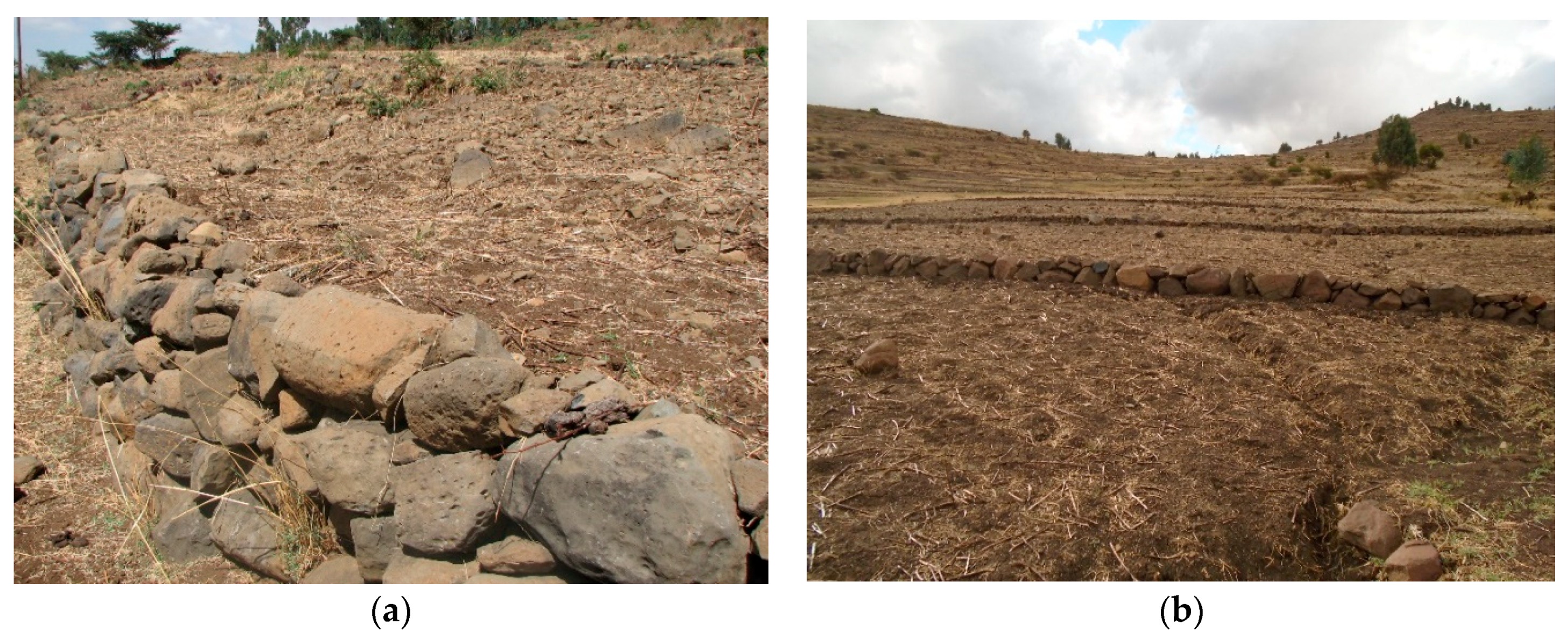
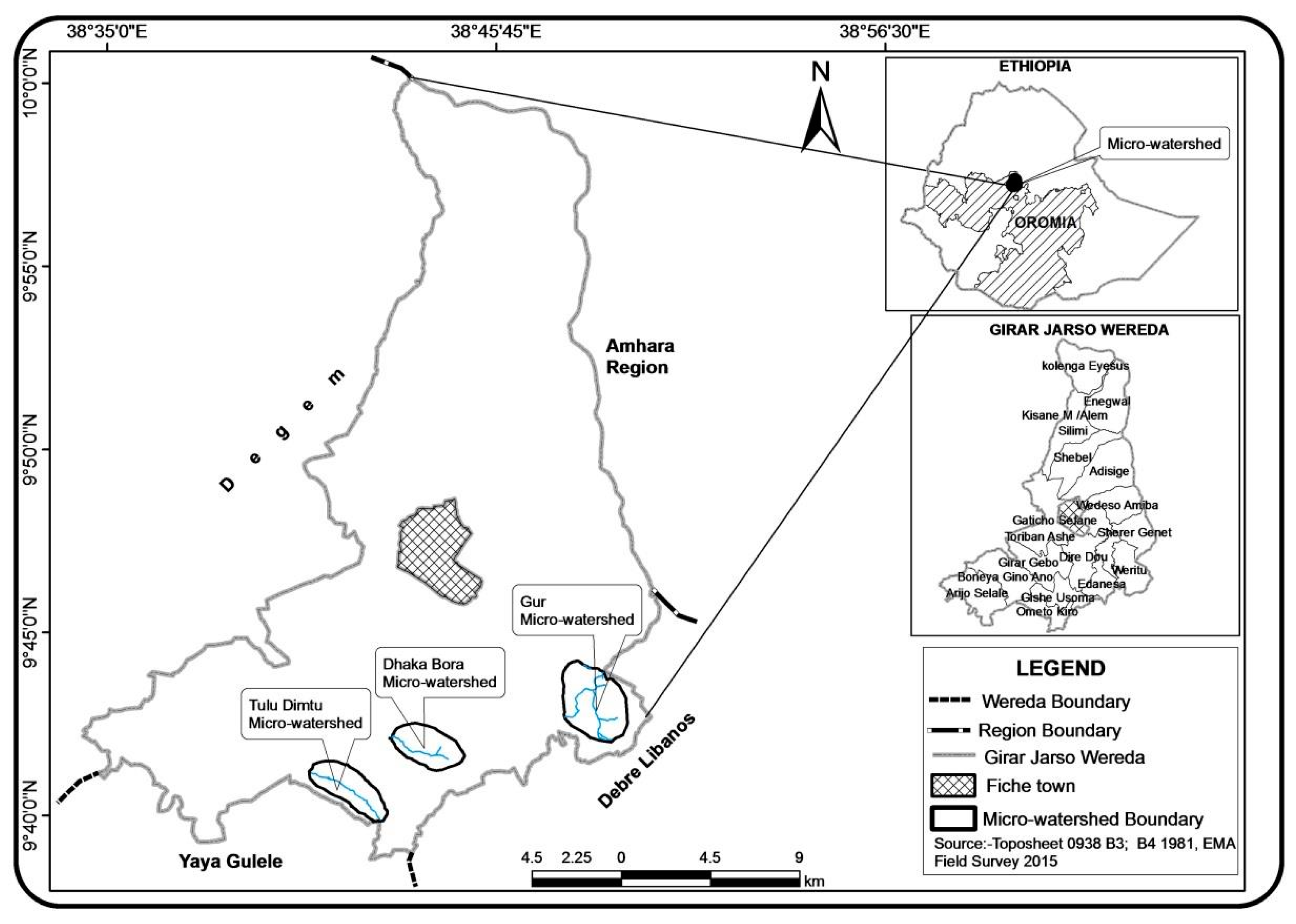
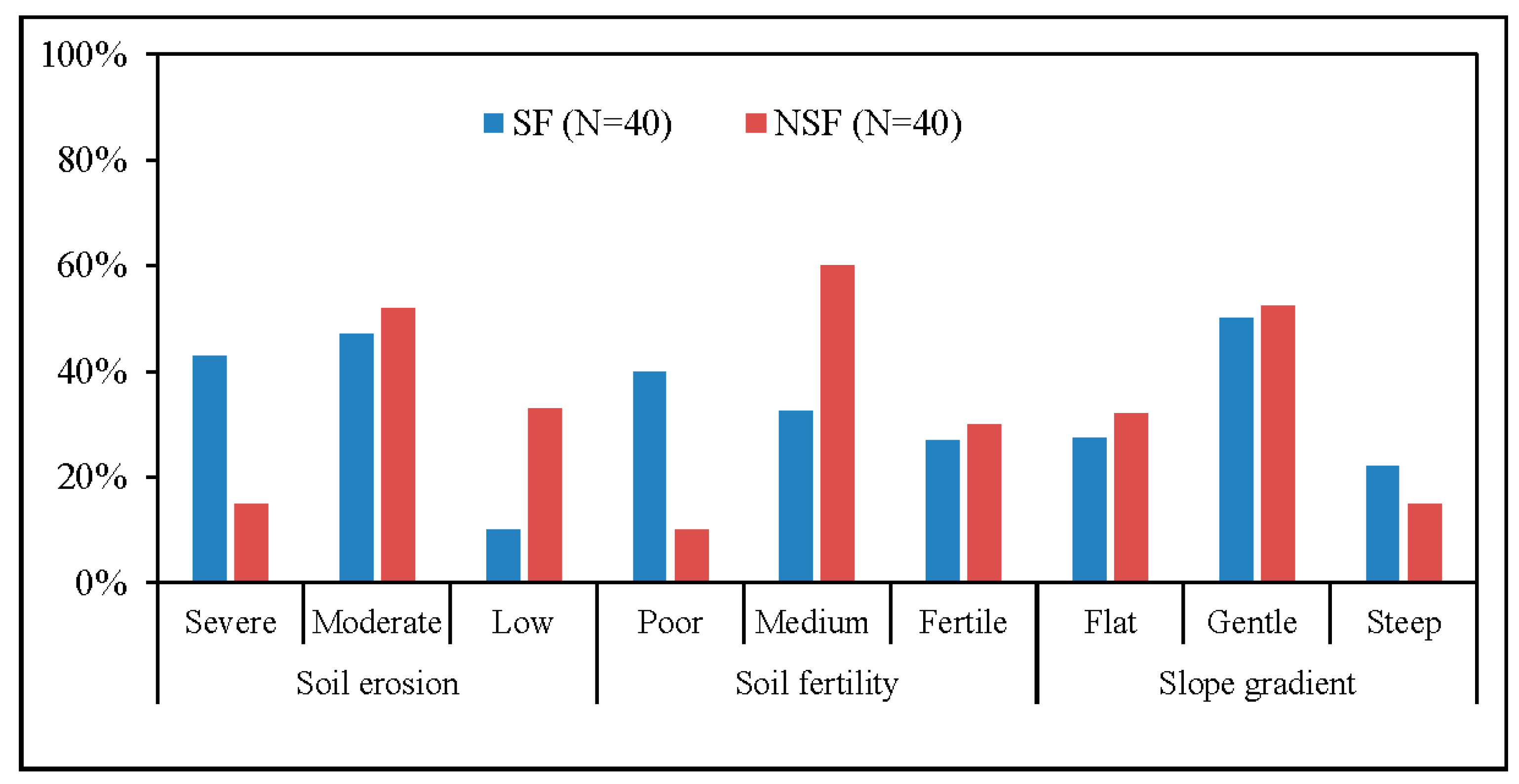
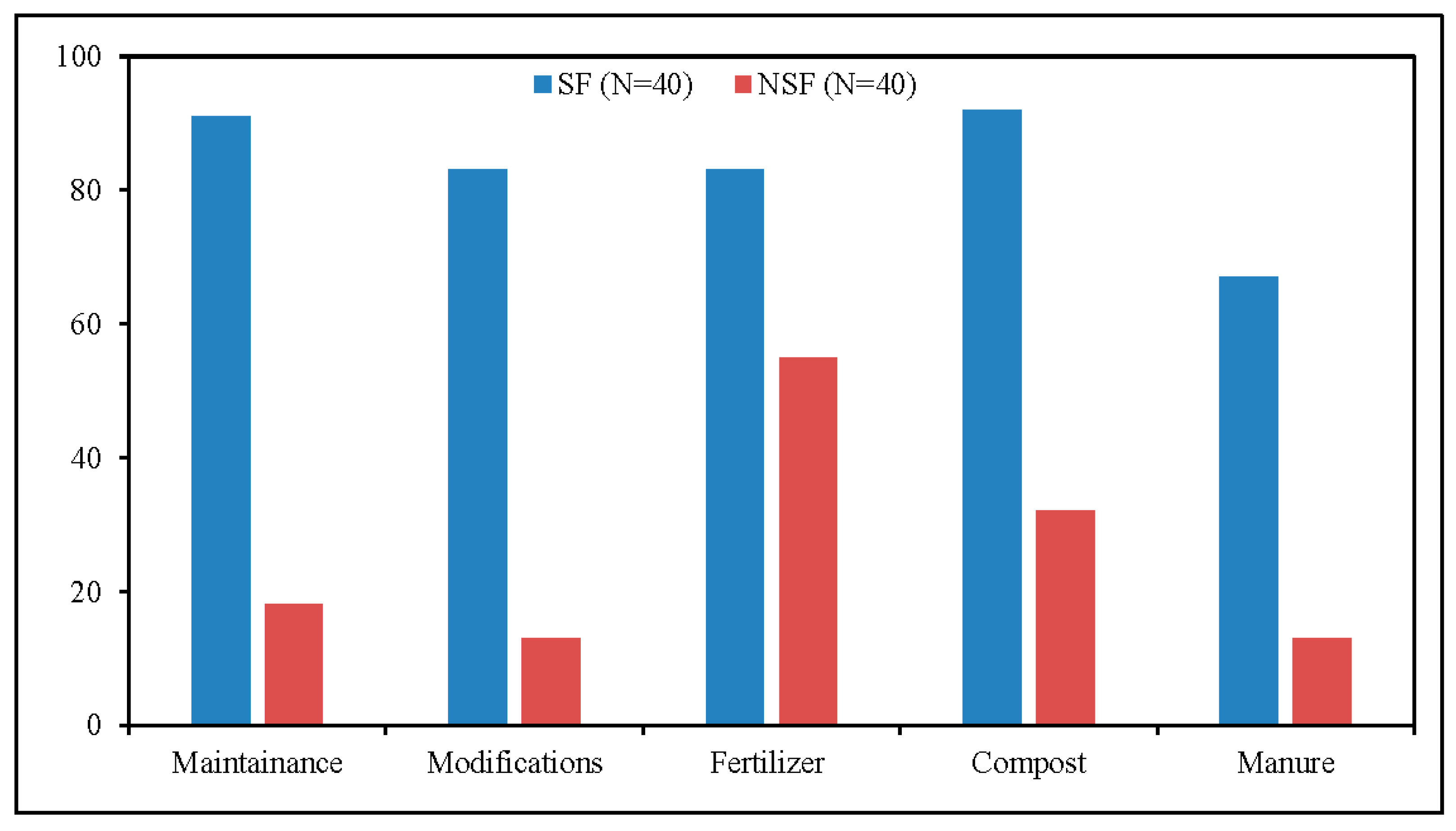
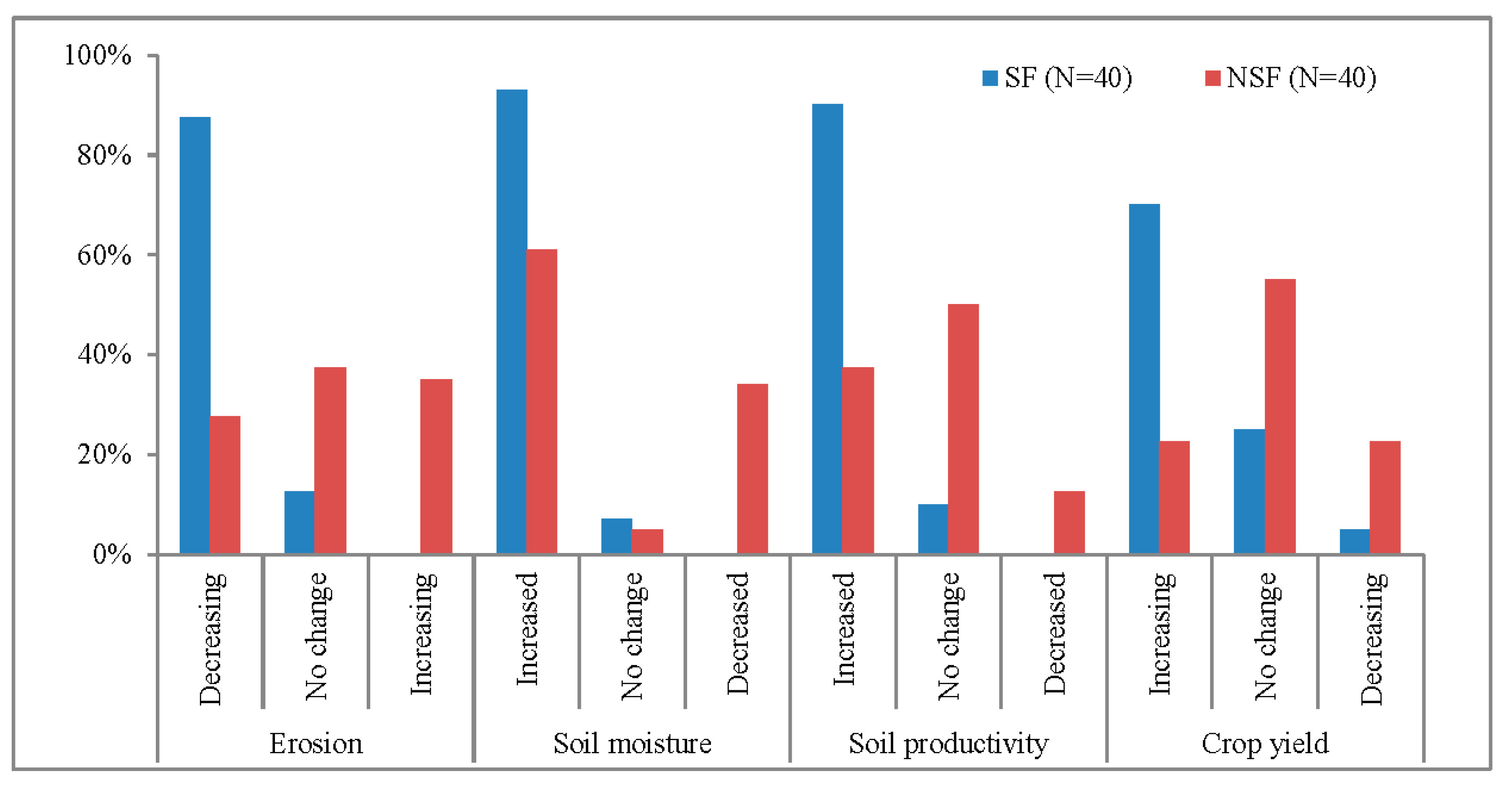
| Variables | Description | Values |
|---|---|---|
| Perceived farmland characteristics | ||
| Farm plot size | Size of farm plots where the stone bunds are implemented | Hectare |
| Soil erosion | Level of erosion before stone bunds implementation | 1 = Severe, 2 = Moderate, 3 = Low |
| Soil fertility | Fertility status where stone bunds are implemented | 1 = Poor, 2 = Medium, 3 = Fertile/Good |
| Slope gradient | Slope gradient where stone bunds are implemented | 1 = Steep, 2 = Gentle, 3 = Flat |
| Distance | Estimated walking distance of the plot to homestead of the farmers | Minutes |
| Stone bund characteristics | ||
| Maintenance | Whether the implemented stone bunds were maintained | 1 = No, 2 = Yes |
| Modification | Whether the implemented stone bunds were modified to make them fit to the local conditions | 1 = No, 2 = Yes |
| Fertilizer | Whether chemical fertilizer was applied together with the stone bunds | 1 = No, 2 = Yes |
| Compost | Whether compost was applied together with the stone bunds | 1 = No, 2 = Yes |
| Manure | Whether manure was applied together with the stone bunds | 1 = No, 2 = Yes |
| Perceived Effects | ||
| Erosion | Effects on erosion after stone bunds were implemented | 1 = Increased, 2 = No-change, 3 = Reduced |
| Soil moisture | Effects on soil moisture after the stone bunds were implemented | 1 = Reduced, 2 = No-Change, 3 = Increased |
| Soil productivity | Effects on soil productivity after the stone bunds were implemented | 1 = Reduced, 2 = No-Change, 3 = Increased |
| Crop yield | Effects on yield after the stone bunds were implemented | 1 = Reduced, 2 = No-Change, 3 = Increased |
| Yield improvement | Believed that yield improvement was only due to stone bunds | 1 = No, 2 = Yes |
| Variables | SF (N = 40) | NSF (N = 4 0) | t-test | |||
|---|---|---|---|---|---|---|
| Mean | Std. Dev | Mean | Std. Dev | |||
| Perceived farmland characteristics | Farm plot size | 0.58 | 0.243 | 0.65 | 0.258 | 0.224 |
| Soil erosion | 1.68 | 0.656 | 2.18 | 0.656 | 0.001 ** | |
| Soil fertility | 1.88 | 0.822 | 2.20 | 0.608 | 0.048 * | |
| Slope gradient | 2.05 | 0.714 | 2.18 | 0.675 | 0.424 | |
| Distance | 13.13 | 8.25 | 31.45 | 7.278 | 0.000 ** | |
| Perceived stone bund characteristics | Maintenance | 1.95 | 0.221 | 1.18 | 0.385 | 0.000 ** |
| Modification | 1.83 | 0.385 | 1.13 | 0.335 | 0.000 ** | |
| Fertilizer | 1.83 | 0.378 | 1.55 | 0.506 | 0.013 * | |
| Compost | 1.92 | 0.280 | 1.32 | 0.475 | 0.000 ** | |
| Manure | 1.67 | 0.478 | 1.13 | 0.341 | 0.000 ** | |
| Perceived effects | Erosion | 2.88 | 0.335 | 1.93 | 0.797 | 0.000 ** |
| Soil moisture | 2.93 | 0.267 | 2.21 | 0.963 | 0.000 ** | |
| Soil productivity | 2.80 | 0.608 | 1.88 | 0.939 | 0.000 ** | |
| Crop yield | 2.65 | 0.580 | 2.00 | 0.679 | 0.000 ** | |
| Yield improvement | 1.21 | 0.418 | 1.56 | 0.527 | 0.053 | |
© 2018 by the authors. Licensee MDPI, Basel, Switzerland. This article is an open access article distributed under the terms and conditions of the Creative Commons Attribution (CC BY) license (http://creativecommons.org/licenses/by/4.0/).
Share and Cite
Abi, M.; Kessler, A.; Oosterveer, P.; Tolossa, D. Understanding the Spontaneous Spreading of Stone Bunds in Ethiopia: Implications for Sustainable Land Management. Sustainability 2018, 10, 2666. https://doi.org/10.3390/su10082666
Abi M, Kessler A, Oosterveer P, Tolossa D. Understanding the Spontaneous Spreading of Stone Bunds in Ethiopia: Implications for Sustainable Land Management. Sustainability. 2018; 10(8):2666. https://doi.org/10.3390/su10082666
Chicago/Turabian StyleAbi, Meskerem, Aad Kessler, Peter Oosterveer, and Degefa Tolossa. 2018. "Understanding the Spontaneous Spreading of Stone Bunds in Ethiopia: Implications for Sustainable Land Management" Sustainability 10, no. 8: 2666. https://doi.org/10.3390/su10082666
APA StyleAbi, M., Kessler, A., Oosterveer, P., & Tolossa, D. (2018). Understanding the Spontaneous Spreading of Stone Bunds in Ethiopia: Implications for Sustainable Land Management. Sustainability, 10(8), 2666. https://doi.org/10.3390/su10082666





